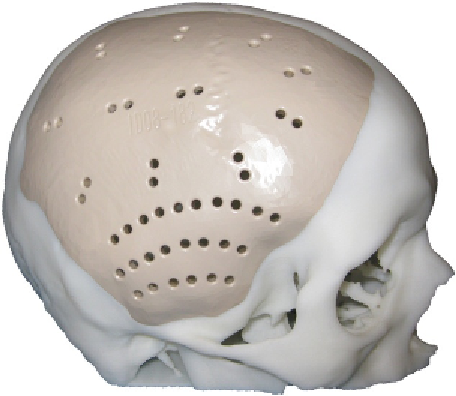Biomedical Engineering Reference
In-Depth Information
but can cause artifacts in MRI. Large metallic
implants are also strong conductors of heat, which
may have an effect on the brain, although this effect
has not been clinically proven
[50]
. Outside of clin-
ical issues, there are some manufacturing difficulties
for metallic cranioplasty implants. Metallic implants
can either be produced by milling a large block of
material or additively using a technique called elec-
tron beam melting (EBM). Milling, either by
machining or ablation, generates a significant amount
of waste material, while EBM requires a secondary
heating operation to reinforce the material
[50]
.
15.4.2 PEEK Cranial Implants
The ideal alloplastic implant material is inert,
lightweight, easy to fit, and adaptable to the defect
[47]
. Frodel
[48]
stated that the best implant will
have low donor-site risk, biocompatibility, a low risk
of infection, provide the best chance for long-term
appearance, and will minimize the complexity of the
surgery and the operating time. PEEK is a remark-
ably versatile material for this application in that it
has high strength and durability
[45]
, a customizable
shape and stiffness, excellent biocompatibility and
chemical resistance, and ideal imaging properties.
PEEK can be manufactured into a customized,
patient-specific implant, closely matching the exact
dimensions of the patient defect. The implants are
then fixated to the bony tissue with standard facial
reconstruction hardware. In the case that further
modifications are required on site, PEEK is highly
workable. Intraoperative modification and contour-
ing are possible in the operating room using a high-
speed drill with a cutting burr. An improvement over
customized titanium, PEEK avoids stress shielding
as its stiffness nearly matches that of healthy cortical
bone. PEEK implants are also resistant to heat and
ionizing radiation, minimizing concerns with
thermal conduction near the brain and toxicity.
PEEK can be sterilized repeatedly by steam and
gamma irradiation
[49]
. Finally, PEEK also facili-
tates critical postoperative diagnostic monitoring of
oncologic and neurogical patients, because it is
translucent to X-rays and is nonmagnetic, gener-
ating no artifacts in CT or MRI
[49]
.
Figure 15.13
shows a customized PEEK implant used for cranial
defect repair.
Still the main disadvantage with PEEK, as with
any alloplastic material, is that there is a risk of
postoperative infection
[46]
. Currently, PEEK has no
Figure 15.13
PEEK skull implant for cranial defect
repair.
Adapted with permission from Lethaus et al. [50].
bioactive potential
[50]
. Also, there is little infor-
mation pertaining to the effect of these large implants
on the soft tissues used to cover them
[50]
. With any
reconstructive material, it is necessary to obtain
adequate well-vascularized, tension-free soft-tissue
closure, possibly using free-tissue transfer
[48,49]
.
The potential of wound breakdown over the implant
is an issue, especially in the case of compression
injuries. Tightening and compression of the soft
tissue due to trauma, contracture from scarring, and
radiation can devascularize the tissue. In the case
where it is necessary, free-tissue transfer can be
performed in conjunction with a customized PEEK
implant.
15.4.3 Clinical Studies
Clinical studies of customized PEEK cranioplasty
implants have reported promising results. Scolozzi
et al.
[46]
reported on a case using a customized
PEEK implant for the reconstruction of a complex
orbito-fronto-temporal defect. The surgery was
a revision following failed treatment with a titanium
mesh implant in which the patient later presented
with progressive wound dehiscence and purulent
discharge. The authors noted that the implant
perfectly matched the dimensions of the defect and
no further modifications were required to shape the
implant or the bone. The patient had stable cosmetic
and dimensional reconstruction at 1 year, without
signs of infection.

